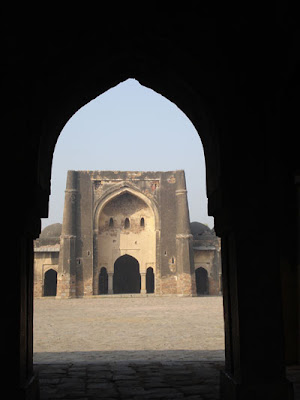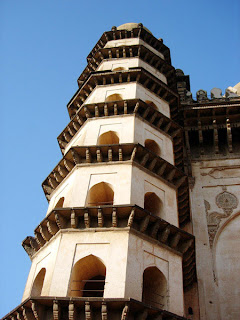






The famous tombs of the seven Qutub Shahi rulers in the Ibrahim Bagh are located close to the famous Golkonda Fort. The tombs are domed structures built on a square base surrounded by pointed arches. The mausoleums of the Sultans of Golkonda, the founding rulers of Hyderabad are truly magnificent monuments that have stood the test of time and braved the elements. The tombs form a large cluster and stand on a raised platform. They display a distinctive style, a mixture of Persian, Pathan and Hindu forms. The tombs are graceful structures with intricately carved stonework and are surrounded by landscaped gardens. The tombs were once furnished with carpets, chandeliers and velvet canopies on silver poles. Qurans were kept on supports and readers recited verses from the holy book at regular intervals. Golden spires were fitted over the tombs of the Sultans to distinguish their tombs from those of other members of the royal family. During the Qutub Shahi period, these tombs were held in great veneration. But after their reign, the tombs were neglected, till Sir Salar Jung III ordered their restoration in the early 19th century. A pretty garden was laid out, and a compound wall was built.All, except the last, of the Qutub Shahi Sultans lie buried here.

It is one of the finest mosques of Gujarat. This is a gigantic structure with two imposing minars on either side of the central entrance to the prayer hall. The dome behind the high central screen of the façade is elevated on two extra storeys of open arcades. The roof just behind this dome is filled by a carved slab of great beauty and ingenuity of workmanship. There are seven mehrabs (prayer niches) in the back wall of the main prayer hall, the central being more elaborated. The northern section of prayer hall was separated by a perforated screen, reserved for ladies from where an extra entrance was provided. A pillared corridor goes round the vast court yard opening inside in ogival arches supported by pillars. The Mosque has three entrance porches to courtyard but the eastern porch is most remarkable for its intricate carving and Jaali work. Outside the mosque, there is an octagonal tank with steps for ablutions. Construction of mosque is datable to late 15th century A.D. Sultan Begada also built this Jama Masjid in Champaner, which ranks amongst the finest architectural edifices in Gujarat. It is an imposing structure on a high plinth, with a central dome, two minarets 30 meters in height, 172 pillars, seven mihrabs, and carved entrance gates.






Jahaz Mahal in Mandu was built in the second half of the fifteenth century. It was a symbol of ‘elegance achieved through the symbiosis of indigenous and outside influences in late Malwa design’. The Jahaz Mahal in Mandu India is located on a narrow strip of land between the two lakes, Munj Talao to the west and Kapur Talao to the east. It stands on the terraces of the adjoining Taweli Mahal. It is a royal pleasure to watch this boat floating on the lake on a moonlit night.
Jahaz Mahal is a double storied, rectangular structure with 3 feet (0.86 meters) thick wall. One must watch the six gothic arched opening in the main entrance of the eastern side of the palace. These arched openings are secluded by a continuous chhajja (awning) supported on stone brackets. There are three large halls in the ground floor which are separated by corridors. The small rooms are located at the ends.
There are numerous fountains and cascades built in the Jahaz Mahal which makes the palaces more beautiful. The charming image of the palace is further highlighted by the reflection of the pavilions in the water. Apart from this romantic ambience, the northern end of the terrace leads to a bath with broad steps leading into it. The present condition of this elegant palace which was once admired by Jahangir the Moghul Emperor needs care and restoration.
 Bidriware
Bidriware
The history of the present fort at Bidar is attributed to the Sultan Ala-ud-Din Bahman Shah the first sultan of the Bahmani dynasty to 1427 when he shifted his capital from Gulbarga to Bidar since it had better climatic conditions and was also a fertile and fruit bearing land. Earliest recorded history of its existence as a small and strong fort is also traced to the The first Muslim invasion of the region is traced to Prince Ulugh Khan in 1322, whereafter it came under the reign of the Tughlaq dynasty. With the establishment of the Bahmani dyanasty (1347), Bidar was occupied by Sultan Alla-Ud-Din Bahman Shah Bahmani. During the rule of Ahmad Shah I (1422–1486), Bidar was made the capital city of Bahmani Kingdom. The old Hindu Fort was rebuilt and beautiful madrasas, mosques, palaces and gardens were raised. Mahmmad Gawan who became the Prime Minister in 1466 was a notable figure in the history of Bidar. Bidar remained under the Barid Shahi dynasty until it was captured by the Mughal emperor Aurangazeb in 1656 A.D. In 1724, Bidar became a part of the Asaf Jahi Kingdom of the Nizams. It was annexed by the Bijapur Sultanate in 1619–20 but the Mughal viceroy of Aurangzeb took it in 1657 and thus became a part the Mughal Empire in 1686. The Fort presently is in bad condition of maintenance by ASI. The world famous bidriware originated from here.
 Srirangapattnam once the capital of Mysore Kingdom under Hyder Ali and Tippoo Sultaun needs attention from the ASI as the walls of this great impregnable fort are falling down. It is believed that Tippoo had a fantastic collection of books in his library which was burt down by the British Sepoys. But some of the remaining books were shifted to London- the treasure can be accessed in IOL London. Hyder Ali is usually noted in history as a"usurper" of Mysore Kingdom- the fact is otherwise. Historians of the day; particularly the British wrote all wrong things about him and Tippoo who was a terror even in the streets of London.
Srirangapattnam once the capital of Mysore Kingdom under Hyder Ali and Tippoo Sultaun needs attention from the ASI as the walls of this great impregnable fort are falling down. It is believed that Tippoo had a fantastic collection of books in his library which was burt down by the British Sepoys. But some of the remaining books were shifted to London- the treasure can be accessed in IOL London. Hyder Ali is usually noted in history as a"usurper" of Mysore Kingdom- the fact is otherwise. Historians of the day; particularly the British wrote all wrong things about him and Tippoo who was a terror even in the streets of London. 

The main feature of the mosque is its distinctive window opening with jalis or tracery known as khirki or latticed windows. Placed on the upper level of the mosque's exterior wall, these jalis were preponderantly carved stone shields. The Khirki mosque as well as the nearby village got its name from this unparalleled feature. The Khirki mosque was built by Khan-I-Jahan, the prime minister of Feroz Shah Tughlaq in the late 14th century and is said to one of the seven mosques built by him. Built on an elevated plinth with detritus stone, which were thickly plastered, the Khirki mosque is double storeyed and has a series of basement cells in the lower storey. All the four corners of the structure are occupied by imposing bastions making the mosque look like a fort. There are dwindling minarets on all the three gateways, except on the west, with the eastern gate being the main entrance. However, at present the southern gate is open for the visitors and the devotees.The courtyard has pillars and is divided into 25 squares with five on each side. Each square is further divided into nine smaller squares. A cluster of nine small low domes made in the Tughlaq pattern covers the following larger squares - the center square of the courtyard with two on the corners, three on each side and one in the middle. The four diagonal squares are left uncovered, through which sunlight found its way to the inner sanctum of the mosque. The remaining squares are covered with flat roofs, thus making the mosque partly covered and partly uncovered. It is said that since Khan-I-Jahan used the mosque for his private worship, it was designed like this to beat the intense heat of the region.
Contact : momaindia@gmail.com


The tomb, located in the city of Bijapur, in Karnataka, Southern India, was built in 1659 by the famous architect, Yaqut of Dabul. The structure consists of a massive square chamber measuring nearly 50 m (160 ft) on each side and covered by a huge dome 43.3 m (142 ft) in diameter making it among one of the largest dome structures in world. The dome is supported on giant squinches supported by groined pendentives while outside the building is supported by domed octagonal corner towers. The Dome is the second largest one in the world which is unsupported by any pillars. The acoustics of the enclosed place make it a whispering gallery where even the smallest sound is heard across the other side of the Gumbaz. At the periphery of the dome is a circular balcony where visitors can witness the astounding whispering gallery. Any whisper, clap or sound gets echoed around 7 times. Anything whispered from one corner of the gallery can be heard clearly on the diagonally opposite side. It is also said that the Sultan, Ibrahim Adil Shah and his Queen used to converse in the same manner. During his time, the musicians used to sing, seated in the whispering gallery so that the sound produced .could reach every corner of the hall.
Email: momaindia@gmail.com



